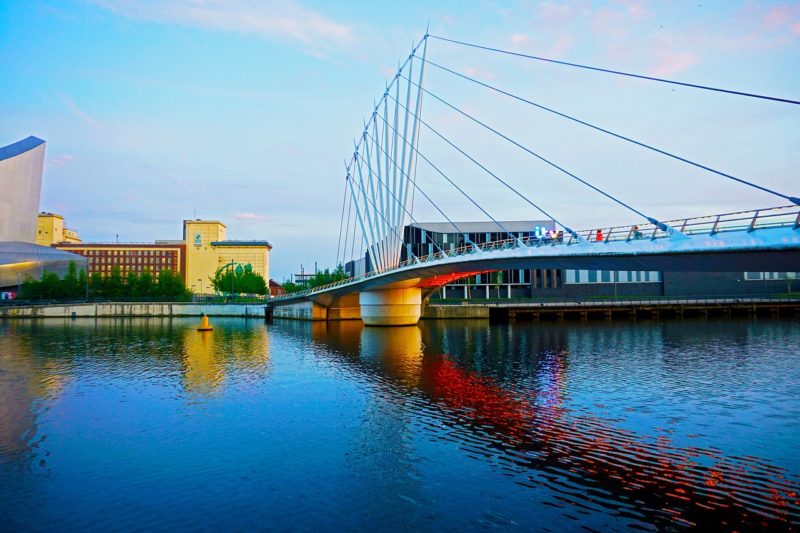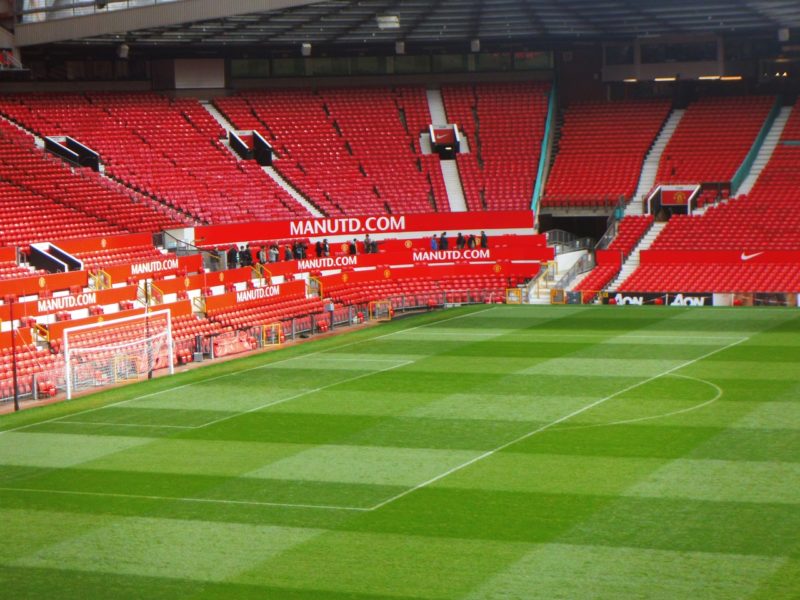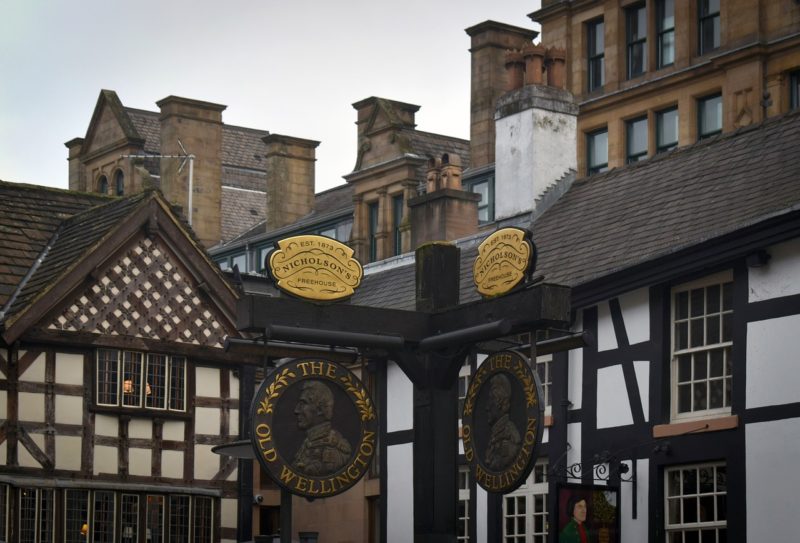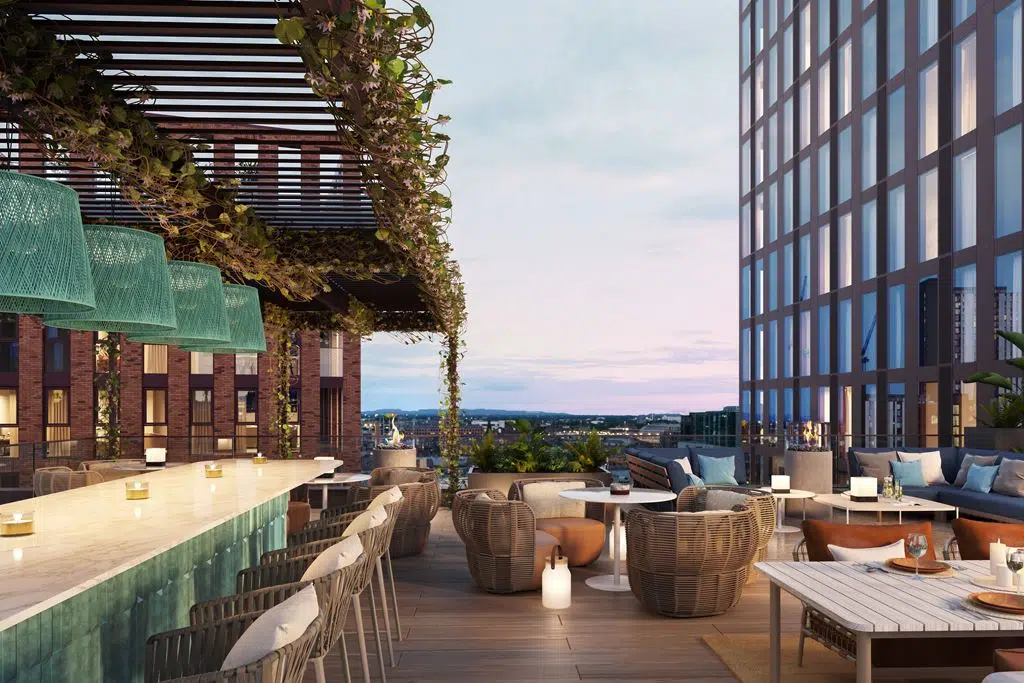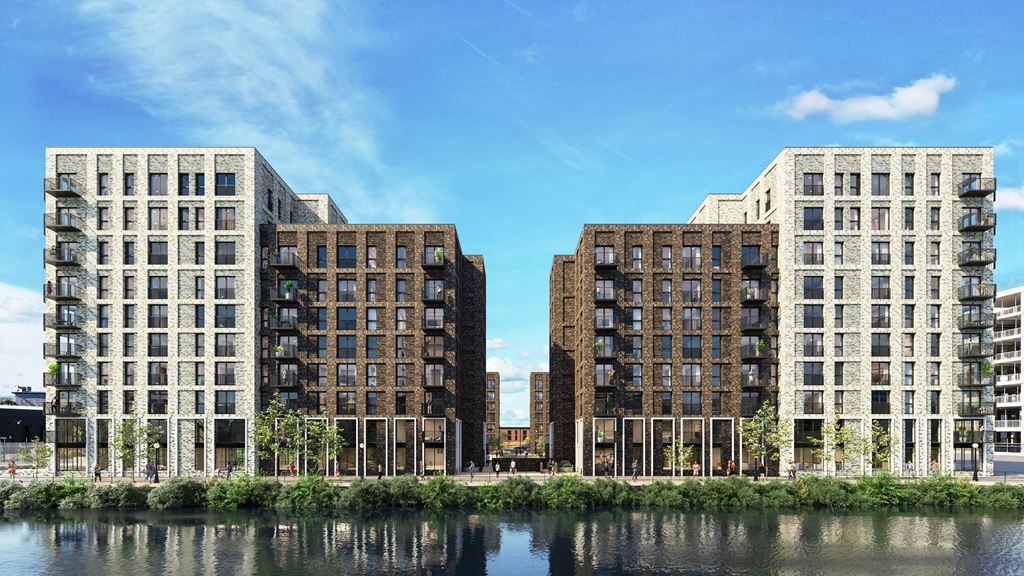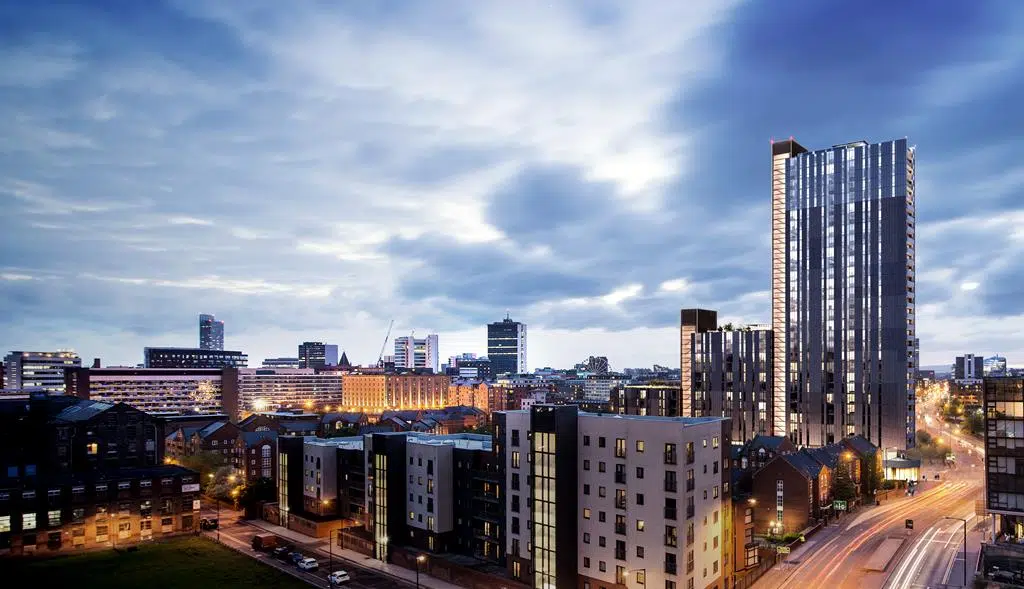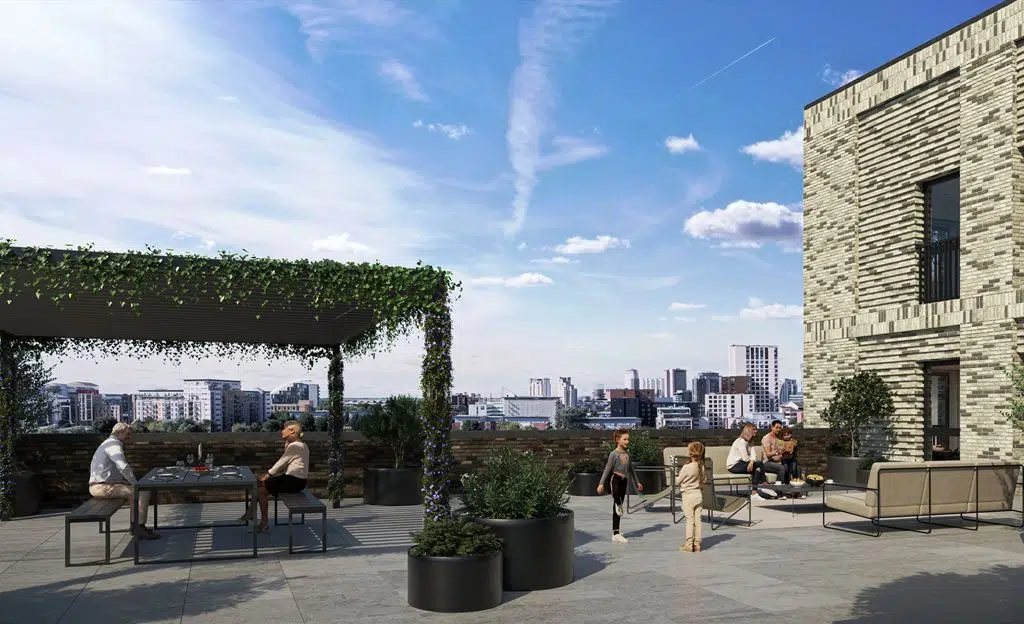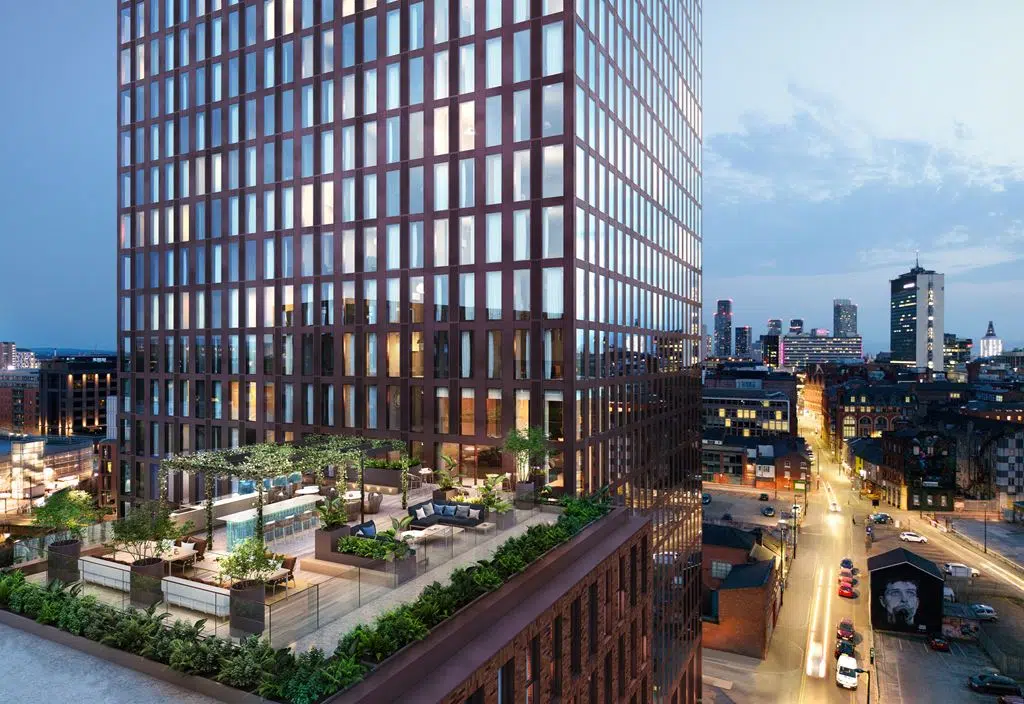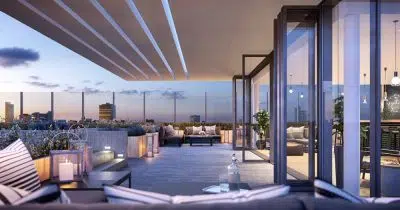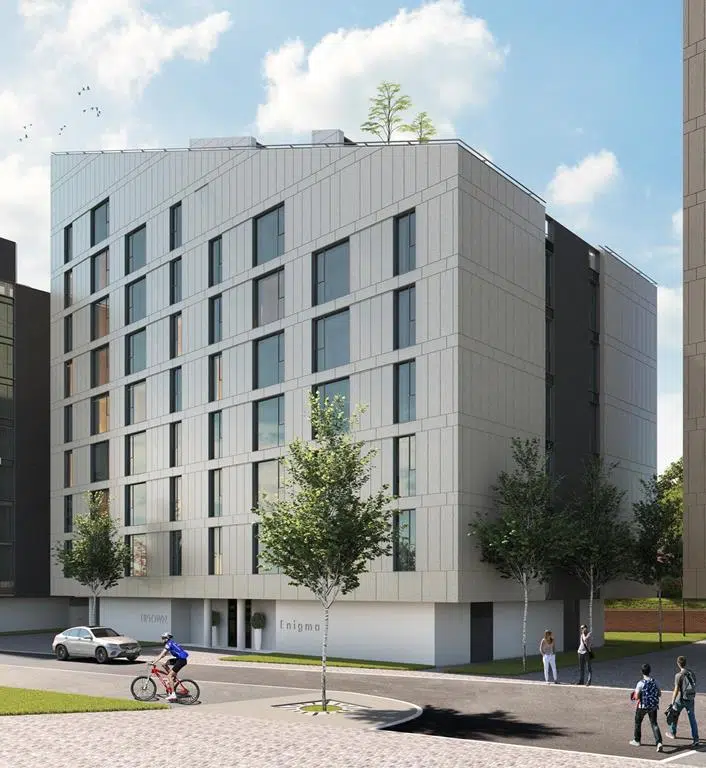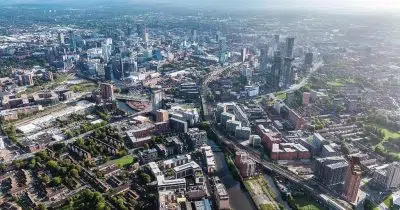Manchester city centre in northwest England is often hailed as the United Kingdom’s vibrant heart with a rich industrial history, world-class football teams, and thriving leisure scenes. London has overshadowed Manchester’s city centre in the past, but over the last decades, this changed and Manchester is now a leading city in Europe and a place to invest in.
From impressive architectural landmarks and world-class museums to diverse culinary, theatre and vibrant nightlife scenes, Manchester offers excellent lifestyles. The city centre is the Uk’s fifth largest, covering 115.6 sq km (44.6 sq mi) and boasting a population of roughly 550,627. Manchester is 160 miles (257 km) northwest of England’s capital, London, and is also a UK hub for commerce, entertainment, and higher education here.
This comprehensive guide explores aspects of Manchester city centre and greater Manchester, from geography and history to attractions and UK investment opportunities. So, without further ado, let’s explore Manchester and discover why this city is easily matching the UK capital of London.
About Manchester in the United Kingdom
History of Manchester as an UK Industrial Powerhouse
It is worth knowing how Manchester has grown, to fully appreciate the current status. Manchester’s history dates from Roman times when the area was established as a civilian settlement and a Roman fort called “Mamucium” in 79 AD. Over the centuries, the Roman fort evolved. Manchester expanded into outer districts and became a UK centre for various industries, including textiles, pottery, and coal mining.
However, the Industrial Revolution led to Manchester’s rapid growth and transformation into an industrial UK powerhouse. During the 19th century, Manchester city centre became the world’s leading centre for the textile industry, earning the nickname “Cottonopolis.” Thanks to the industrial revolution, the city centre attracted workers from all over the UK and worldwide, resulting in a diverse population and a rich cultural heritage. This era is known as Manchester’s golden age.
In the 20th century, Manchester city centre experienced decline as the industrial revolution waned. However, the city centre underwent significant regeneration in the late 20th and early 21st centuries, with substantial investments in infrastructure.
Today, Manchester is a thriving, modern UK city centre that proudly celebrates its industrial past while embracing a bright future. Industrial history is evident in mills, warehouses, and canals, while modern architecture and infrastructure reflect the vision for the future.
From the Past to Modern Times in Manchester
Much as the past is to be celebrated, modern ties determine a city’s future. London always had the edge as a global alpha city. To be considered as such, the city must excel in every area of business, life and trade, including tourism, education, real estate, and finance. While Manchester hasn’t quite achieved the status of the global alpha city, it is fast matching London in other areas of life.
Greater Manchester: Manchester is the centrepiece of the Greater Manchester metropolitan county, which consists of ten boroughs. The Greater Manchester area has a significantly larger population of over 2.8 million.
Economy: Manchester’s diverse and robust economy contributes to finance, media, technology, manufacturing, and creative industries.
Education: Manchester features several prestigious universities, including the University of Manchester, Manchester Metropolitan University, and the Royal Northern College of Music. These institutions attract many students.
Transport: Manchester Airport, just outside the city, is the third busiest UK airport serving domestic and international flights. The city’s well-developed public transportation system includes trams, buses, and trains.
Sports: Manchester has a rich sporting heritage is known for its passionate football (soccer) culture. The two major football clubs, Manchester United and Manchester City, have significantly succeeded in UK competitions and abroad.
Culture: Manchester is renowned for its vibrant music scene, with a history of influential bands and artists emerging from the city. It also has a thriving arts and cultural sector, with numerous museums, galleries, theatres, and music venues.
Tourism: Manchester attracts a significant number of tourists each year. Visitors explore historical landmarks, such as the Manchester Town Hall and Manchester Cathedral, and modern attractions, like the National Football Museum.
Exploring Arts and Culture in the City of Manchester
Much as the industry’s status is to be celebrated, the city of Manchester also excels in art and culture. Located at the heart of Salford Quays, The Lowry pays tribute to local artist L.S. Lowry. The centre houses two theatres, the Lyric and the Quays, which host theatre, dance, comedy, and music performances.
Opened in 2015, HOME is Manchester’s hub for contemporary film, cinema, and theatre. This impressive cultural complex features two theatres, five cinema screens, and an art gallery showcasing international and local talent.
The Manchester International Festival showcases new and innovative art and culture from around the UK and worldwide. The festival features performances, exhibitions, and installations in venues across the city. Past events have included world premieres of works by artists like Björk and Marina Abramovic.
Manchester Arena
The Manchester Arena, officially known as the AO Arena due to a naming rights agreement, is one of Europe’s busiest and largest arenas, with a seating capacity of 21,000 people. The Manchester Arena hosts many events, including concerts, live music performances, sports events, comedy shows, and other entertainment spectacles. In addition, many world-renowned artists and bands have performed at the arena, making it prominent on international concert tours.
Football and Manchester
Anyone who knows Manchester well will testify to the football legacies. Football is embedded into the city’s heart as one of the UK’s significant teams. Football revolves around two stadiums that serve as important sporting and cultural locations in Manchester. Anyone can also sign up for a guided tour on numerous days. The home stadium for Manchester’s two major football clubs are
Old Trafford: Old Trafford is the home stadium of Manchester United Football Club. Old Trafford, an iconic UK football stadium, has a seating capacity of 74,000 spectators. It has been the home location of Manchester United since 1910.
Etihad Stadium: The Etihad Stadium, the home stadium of Manchester City Football Club, features a seating capacity for 55,000 spectators and has been Manchester City’s home location since 2003.
Prominent Landmarks in Central Manchester
Manchester Cathedral: The 15th-century Manchester Cathedral, displaying Gothic architecture, has been a place of worship and a symbol of history and heritage for centuries. Explore the beautiful interior, attend services, or join events held annually.
Museum of Science and Industry: The Museum of Science and Industry (MOSI) in the Castlefield district is for anyone interested in Manchester’s industrial past. Housed in the former Liverpool Road Station, the museum features interactive exhibits about history, science, and technology. Highlights include the world’s oldest surviving passenger railway station, a replica of the world’s first stored-program computer, and the Power Hall site, which houses vintage steam engines and locomotives.
John Rylands Library: This stunning neo-Gothic library attracts book lovers and architecture enthusiasts alike. Built-in the late 19th century to house the private collection of Enriqueta Rylands, the library houses 1.4 million rare books, manuscripts, and artefacts. Among famous items is the St. John Fragment, the oldest known piece of the New Testament. Explore the library’s breathtaking reading room, attend exhibitions, or marvel at the stunning architecture.
Imperial War Museum: IWM North is a UK branch of the Imperial War Museum situated on the Manchester Ship Canal in Trafford Park. IWM North opened in July 2002 and is housed in an award-winning building designed by architect Daniel Libeskind. The imperial war museum focuses on the effects of war on individuals and communities and technology and innovation in warfare. IWM North features exhibitions, displays, and interactive installations that engage visitors and provide insight.
Market Street
Market Street thoroughfare in Manchester city centre offers countless shops. It serves as a central hub for both locals and visitors. Market Street connects Piccadilly Gardens to St. Ann’s Square, and the pedestrianized street closed to vehicle traffic, is lined with various high street chains, department stores, independent shops, cafes, and restaurants, offering retail options. In addition to countless shops and eateries, Market Street also features notable landmarks and buildings.
One such landmark is the iconic Manchester Arndale, a large indoor shopping centre on Market Street. The Arndale is one of the UK’s largest city-centre shopping centres with many shops. The street is well-connected to public transportation, with several tram stops and bus routes. This accessibility makes it convenient for residents and visitors to explore the city centre and access other parts of Manchester.
Market Street, an important part of Manchester’s retail and cultural landscape, offers many shopping, dining, and entertainment options. It continues to adapt to changing needs and trends of vibrant and diverse communities.
Albert Square
The square, named after Prince Albert, Queen Victoria’s husband, was laid out in the mid-19th century as part of Victorian redevelopment. Albert Square is dominated by the impressive Manchester Town Hall, a Grade I listed building that serves as the ceremonial headquarters of Manchester City Council. The town hall’s iconic clock tower, the Albert Memorial, also stands tall as a recognizable feature. Albert Square is often the venue for public events, festivals, and demonstrations.
The square is particularly significant during Manchester’s annual Christmas Markets, attracting millions of visitors worldwide. Surrounding Albert Square, you will find other notable buildings and landmarks. The square is flanked by St. Peter’s Square, where you can find the Central Library and the iconic St. Peter’s Square tram stop.
In addition, the square sits near other vital sites like Manchester Central Convention Complex and the Midland Hotel. Albert Square is a significant civic space for people to relax and enjoy their surroundings. It features landscaped gardens, seating areas, and a central fountain.
Oxford Road
Oxford Road in the southern city centre extends southwards towards Fallowfield and is prominent in UK education, culture, and transportation. The University of Manchester, a leading UK education hub, has its main campus here. Manchester Metropolitan University further contributes to the educational hub’s reputation.
The Whitworth Art Gallery showcases art and hosts temporary exhibitions and is along the road. The contemporary Contact theatre is another cultural landmark. Part of Manchester University, the Whitworth Art Gallery is renowned for British watercolours, textiles, and wallpapers. The gallery also houses modern and contemporary art, featuring works by well-known artists like Barbara Hepworth, Henry Moore, and David Hockney.
Culinary Delights of Manchester: Best Restaurants and Food Spots
Mackie Mayor: In the trendy Northern Quarter, Mackie Mayor food hall is set within a beautifully restored Victorian market building, with an impressive selection of food and drink vendors, sample artisan pizza, Chinese restaurants, mouth-watering burgers, Vietnamese street food, and freshly shucked oysters.
Bundobust: This popular Indian street food joint offers unique dining experiences. With vibrant atmospheres, delicious vegetarian menus, and an extensive craft beer selection, Bundobust is a paradise for the best Indian cuisine in Manchester City.
The French: Inside the historic Midland Hotel, The French is one of Manchester’s most prestigious restaurants. Helmed by acclaimed chef Adam Reid, the restaurant offers refined dining experiences with seasonal, locally sourced ingredients. With an elegant setting and impeccable service, The French are perfect for special occasions or romantic evening outs.
Rudy’s Neapolitan Pizza: Rudy’s Neapolitan Pizza sells authentic, wood-fired Neapolitan pizza in Manchester. Rudy’s attracts locals and tourists with simple yet delicious menus and relaxed atmospheres. Be prepared to queue, though, as this popular spot gets busy!
The Curry Mile: Curry Mile, in the Rusholme neighbourhood, stretches for one mile and features over 70 South Asian restaurants, cafes, and shops. This is the location to eat various cuisines from Indian and Pakistani to Bangladeshi and Middle Eastern.
Manchester’s Thriving Nightlife and Music Scene
Manchester’s Northern Quarter is the city’s hub for independent bars, pubs, and music venues. The area attracts diverse crowds of locals and visitors looking for good nights out. Some must-visit spots include the Soup Kitchen music venue and bar, and Port Street Beer House, selling rotating selections of brews. Meanwhile, Canal Street, in Manchester’s Gay Village, features bars, clubs, and restaurants catering to LGBTQ+ communities. For unique and unforgettable nights out, the Warehouse Project features leading UK DJs and electronic music acts held in industrial warehouses and venues across Manchester.
Shopping in Manchester: From High-end Boutiques to Unique Independent Stores
King Street: King Street offers high-end luxury shopping in Manchester. The street has designer boutiques, including Burberry, Dior, and Hermès, and upscale department stores like Harvey Nichols and Selfridges. Also, admire the street’s beautiful architecture, with many Victorian-era buildings.
Afflecks: Afflecks indoor market in the Northern Quarter offers independent stores selling everything from vintage clothing and handmade jewellery to comic books and vinyl records.
Manchester Arndale: Manchester Arndale is the city of Manchester’s largest shopping centre, with over 200 stores selling everything from fashion and beauty to electronics and home furnishings. The centre also features a food court, cinema, cafes and restaurants, making for great shopping and exploring.
Manchester’s Green Spaces: Parks and Gardens
Heaton Park: Heaton Park is one of Europe’s largest municipal parks covering over 600 acres. Explore beautiful gardens and woodlands, with plenty of walking and cycling routes.
Fletcher Moss Botanical Gardens: Fletcher Moss Botanical Gardens in Didsbury Suburb includes a rose, rock, and Japanese garden. Explore historic buildings, including the Tudor-style Fletcher Moss House.
The Peak District National Park: While not technically in Manchester, the Peak District National Park is only a short drive away and is for nature lovers. The park features stunning landscapes, including rolling hills, rugged moors, and picturesque villages. This is where to enjoy hiking, cycling, and rock climbing and explore the area’s historic sites and charming towns.
Greater Manchester and Surrounding Areas
Ok, so Manchester city centre has come a long way. Still, separating the region into the city centre and the greater Manchester areas is helpful to know more. Beyond Manchester’s city centre, the surrounding Greater Manchester boroughs offer quaint market towns, traditional pubs, beautiful green spaces and waterways to explore on foot or bike.
With its rich history, diverse culture, and beautiful countryside, the Manchester city council extends its commitment to the greater Manchester districts. Some charming towns and villages in this part of England include Bolton, Bury, Rochdale, Oldham, Ashton-under-Lyne, and Stockport.
Saddleworth, nestled within the Pennine hills, is where to enjoy leisurely walks and cosy country pubs. Another gem within Greater Manchester is Bolton, a town steeped in history with thriving cultural scenes. The town also features the famous Octagon Theatre. And let’s not forget the breathtaking West Pennine Moors surrounding Bolton – a haven for wildlife and an ideal spot for outdoor pursuits like hiking, cycling, and birdwatching.
Meanwhile Altrincham market town has undergone revitalization and is now a foodie location. And just a stone’s throw away from Altrincham is Dunham Massey deer park and beautifully landscaped gardens. Salford’s rich industrial heritage, much like the city of Manchester, stems from the thriving textile sector during the Industrial Revolution.
Today, Salford features mixed residential, commercial, and cultural areas. MediaCityUK in Salford, a major UK media and digital hub, houses various television studios, production companies, and creative agencies. Salford Quays, located on the Manchester Ship Canal, underwent significant redevelopment and transformation. Salford and the city of Manchester are closely connected by transportation networks, including tram and bus services, making it easy to travel between the two.
In Conclusion
Manchester Centre, with an excellent location, rich history, diverse culture, and bustling atmosphere, is a fantastic city to visit, live, and invest in. Manchester City has something for everyone, from fascinating attractions and vibrant nightlife to excellent transport links, locations and investment opportunities. There are several reasons why buying property in Manchester can be an attractive prospect. Here are some key factors:
Strong Economic Growth: This thriving city includes diverse economies and good locations, including industries like finance, creative and digital, healthcare, education, and more. The city has attracted substantial investments and development projects, created job opportunities and contributed to overall economic prosperity.
Property Price Growth and Affordability: Property prices in Manchester have risen steadily, indicating strong potential for capital appreciation. However, compared to other major UK cities like London, Manchester’s property prices are relatively more affordable.
Rental Demand: Manchester’s rental market is driven by the student population, young professionals, and international residents.
Regeneration and Infrastructure Development: The city has undergone extensive regeneration projects, transforming former industrial areas into vibrant residential and commercial zones.
Education and Research Institutions: Manchester features renowned universities, including the University of Manchester and Manchester Metropolitan University. The presence attracts a large student population and contributes strongly to education.
Cultural and Social Vibrancy: Manchester offers rich cultural scenes, diverse communities, and vibrant social life. The city location offers cultural attractions, entertainment venues, restaurants, and shopping centres, providing residents with a quality of life.
Unlock the Potential: Invest in Manchester’s Promising Property Market Today
Don’t miss out on the exceptional opportunities Manchester’s property market offers. So take the leap and invest in this thriving city today! Our Manchester portfolio features the latest investment destination and project developments. Each listing contains everything to know. Or contact us today and speak with an agent about investing in Manchester in the United Kingdom.
More About Investing in the UK
Best Places to Invest in UK Property: From Liverpool to Birmingham, Manchester and Nottingham, if you don’t want to invest in property in London, these are the top destinations to buy property in the UK. This article also discusses types of property to invest in, rental demand, how to find UK property for sale, the buying process, and managing your investment for a profitable return.
Buying Holiday Homes in the UK: For decades, the UK has reigned supreme on the holiday home market, having enjoyed a long-time reputation for the good old-fashioned UK getaways. But, as always, research potential real estate investment thoroughly to ensure it pays off. So, in this article, we look at reasons to buy and where.
